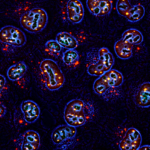Lien vers Pubmed [PMID] – 7882370
Cancer Res. 1995 Apr;55(7):1590-7
Acute promyelocytic leukemia is associated with a t(15;17) translocation that generates a fusion product between PML and the retinoic acid receptor alpha. Recently, PML was shown to concentrate within subnuclear domains, referred to as nuclear bodies, that are disorganized in acute promyelocytic leukemia cells. This observation provided the first evidence that alteration of a nuclear structure may play a role in human pathogenesis. In an attempt to clarify the role of PML and, more generally, of the associated nuclear bodies, we used immunohistochemistry to explore the expression of PML in normal, inflammatory, and neoplastic human tissues. With the exception of endothelial cells and macrophages that contain a high amount of PML protein, a weak speckled labeling pattern was observed in the nucleus of all cell types analyzed. By contrast to normal tissues, the level of PML expression was considerably enhanced in inflammatory tissues, predominantly around the mononuclear cell infiltrate, as well as during either normal or pathological proliferative states, in particular in tumoral pathology. Surprisingly, in most hepatocellular carcinoma, a cytoplasmic delocalization of PML was observed. Finally, the number of PML nuclear bodies increased up to twice their normal value as quiescent cultured cells were stimulated to grow upon serum addition. Altogether these results strongly suggest that the PML-associated nuclear bodies are implicated both in the inflammatory process and in cell growth control.

